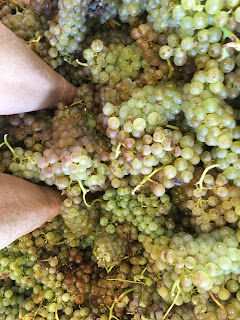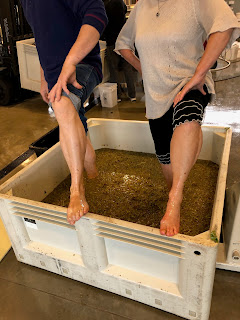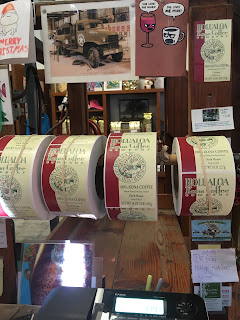When it turned out that Mike's family and mine were scattered in various places doing various things for Christmas this year and that we would therefore be having our first Christmas together with just each other, I said, "Let's eat, drink, and be merry!" (Mike is my husband, as of last May. See posts on May 23 and May 30.)
Food would be the focus. For days I pored over cookbooks before choosing an easy bacon-and-tuna linguine for Christmas Eve dinner and savory crepes (made with cornmeal and beer) with sausage for Christmas morning breakfast. For Christmas dinner we would have a pumpkin-and-persimmon soup, a beef tagine over butternut squash, a salad of beets, cauliflower, and carrots, and, for dessert, the Christmas-present cakes, two days in the making, now waiting in the freezer. (See my food blog, foodaspoem.blogspot.com for a description.)
A few days later I left the Ashland Food Coop with my shopping bags overflowing with beautiful food: onions and oranges, squashes and pumpkins, cartons of cream, wedges of cheese, chocolate. The butcher at Cartwright's Market helped me select the best meat for the tagine, a Moroccan dish of short ribs in a rich sauce of broth, wine, prune juice, and spices. I maybe wasn't returning home with the fluttering quails and live turtle that Babette brought across the sea from France to Denmark for her feast in the movie Babette's Feast, but I was returning home with some of the excitement she felt, too, about preparing to cook good things to eat.
On Christmas Eve Mike arrived at my house with his best bottle of wine and with brandy for the eggnog. After dinner (which Mike liked a lot, though I cautioned him that it wasn't the Christmas meal), we watched Babette's Feast because I had been thinking so much about it and because Mike had never seen it. Mike wasn't to expect quite cailles en sarcophage, I said, but our meal, too, would take hours to make. And though I understood Babette's having no need for her guests to rave over the fantastic meal she had prepared for them (her expressing herself with her art being satisfaction enough), nonetheless, I told Mike, I hoped he wouldn't just talk about the weather while he was eating my hours-in-the-making Christmas dinner, as Babette's guests had done. Unlike Babette, if the food was good, I wanted acknowledgement that it was so.
On Christmas Day the eating, drinking, and being merry started with coffee, homemade bread from my neighbor, and homemade nectarine-lime jam from Mike's daughter, Zoey. Then we opened gifts, then had our crepes with sausage, which weren't as good as I had thought they would be, but no matter. On with the merriment!
After brunch and before delving into the four hours of dinner preparation, Mike and I took a long walk up the mountain. The fresh air and physical exertion were just what we needed. It was 3:00 when we got home.
And then didn't we make a flurry in the kitchen!
Mike, sous-chef, cut up the pumpkins and onions while I prepared the persimmons and gathered the spices and cream for the persimmon-and-pumpkin soup. While the soup was cooking, I cleaned the kitchen. Mike prepared the meat for the tagine. I sautéed onions and measured wine, broth, and juice into the pot. While the meat simmered in the sauce, I cleaned the kitchen (again). We sipped eggnog with brandy. We prepared and cooked the squash. I decided we had enough to eat without the salad and was glad enough not to have to be cooking beets. I sautéed more onions and put them in a beef broth for the couscous. Complex odors circulated through the kitchen. We set the table with a green tablecloth and white candles. Mike poured the wine.
We toasted "Merry Christmas" to each other. We took a moment to appreciate the beautiful food before us: the yellow-orange soup and the dark meat shining with its glaze of spices, juices, and broths on a platter of dark orange, honey-glazed butternut squash in front of a bowl of couscous pearls flecked with mint.
And then we ate.
It was utterly delicious. The soup was silky smooth and brisk with pumpkin and persimmon flavors. The tagine was dark and rich, flavored with cinnamon, cumin, all-spice, and ginger, perfectly complemented by the squash and minted couscous.
The piece de résistance was the dessert, little squares of cake, with strawberry ice cream and lemon curd sandwiched between cake layers, covered with a rich, brandy-laced chocolate ganache with strips of white icing made to look like ribbons on a package. They were superb.
It was all superb. We had spent the day eating, drinking, and being merry. Our first Christmas together was a grand celebration.
The after-dinner port was almost superfluous.









































